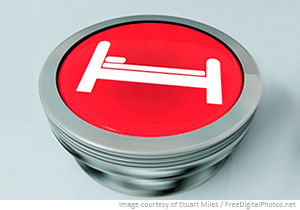
Fall prevention has been one of the most challenging issues facing providers of healthcare for as long as, well, for as long as there have been providers of healthcare.
Not only do falls have serious impacts on patients, but healthcare facilities themselves are impacted negatively by falls. A Centers for Medicare & Medicaid Services (CMS) Final Rule in 2007 meant hospitals no longer receive payments for treating injuries resulting from in-hospital falls.
Not only are Americans living longer, but their list of co-morbidities is growing longer and the potential for falls is increasing as well. Those most vulnerable among us are receiving care by facilities experiencing intense regulatory, financial and ethical pressure to prevent falls. Thought leaders, experts on falls and healthcare providers are analyzing data and outcomes in attempt to identify effective and ineffective means of fall prevention.
One device which has recently come under scrutiny is the personal alarm. Personal alarms have been in widespread use for approximately 25 years, since the federal mandate by Congress in the Omnibus Reconciliation Act of 1987 went into effect in October of 1990 mandating the restriction of restraints in nursing facilities.
Personal alarms can come in several forms:
- A magnet or pull-pin clipped to an item of clothing, which is activated when the person moves forward or otherwise pulls on the cord
- Pressure-sensitive pads placed in the seat of the patient’s chair or on the mattress, which are activated when the patient lifts off the pad
- Pressure-sensitive mats placed on the floor, which become activated when a person steps on the mat
- Light beams directed on the bed or across a doorway which activate when the beam is crossed
Personal alarm use presents several challenges requiring vigilant monitoring by caregivers. Patient compliance is a very common issue. It doesn’t take very much initiative to learn how to turn off the alarms, and many do. The alarms depend on batteries in order to function and sometimes the batteries are not replaced in a timely manner. Caregivers turn the alarms off while providing care and sometimes forget to turn them back on. Let’s not forget that the costs of the devices can be quite high as well.
One major criticism for the use of alarms is this: once the alarm has been activated, the patient is already on the move. Therefore, to intervene in a potential fall, the caregiver must be close enough in proximity to the patient to enable him/her to reach them in time to prevent the fall. Even if close in proximity when an alarm sounds, a caregiver may likely be in the midst of providing care to another patient and unable to respond immediately.
In addition to the questionable effectiveness of personal alarms, some facilities have identified another motivation for eliminating their use: to reduce a culture of “institutionalization” in favor of a culture more conducive to a “living center.” High-pitched piercing alarms are not very fitting for an environment such as a living center.
Some facilities are reporting successful programs wherein they successfully eliminated alarms with no increase in falls or serious injury. The Hebrew SeniorLife Center in Roslindale, MA has done so for its facility of 600 residents by implementing “purposeful rounding.” Purposeful rounding entails more than simply poking one’s head in the room of a patient/resident for a visual check. It involves posing a series of questions related to the individual’s bathroom, hunger, thirst and pain needs and responding accordingly.
Medina Memorial Hospital, a hospital-based skilled nursing facility in Medina, New York, is another facility reporting successful alarm elimination by focusing on each specific resident’s daily life pattern and initiating care plans to address that individualized pattern.
Resources for assistance/tips/guidelines to reduce falls and alarms are growing as well. The Pioneer Network is a nonprofit advocacy group committed to promoting a move “away from institutional provider-driven models to more humane consumer-driven models” in a long-term care culture change movement. Their Starter Toolkit is worth checking out for practical advice in engaging all staff members when implementing practice changes.
Action Pact, another organization committed to culture change in long-term care, is offering a workshop, Eliminating Alarms and Preventing Falls by Engaging with Life. The workshop will take place in San Antonio, TX on June 16, 2015.
The evidence to support “no” as the answer to the use of alarms is increasing. The stakes have never been higher than they are today, as evidenced by increasing regulatory, financial and ethical motivational factors to reduce or eliminate the use. Is your facility/organization considering an answer to the question of alarm use?
Deborah McElhannon, RN, LNCC, RN Consultant Lead - PL